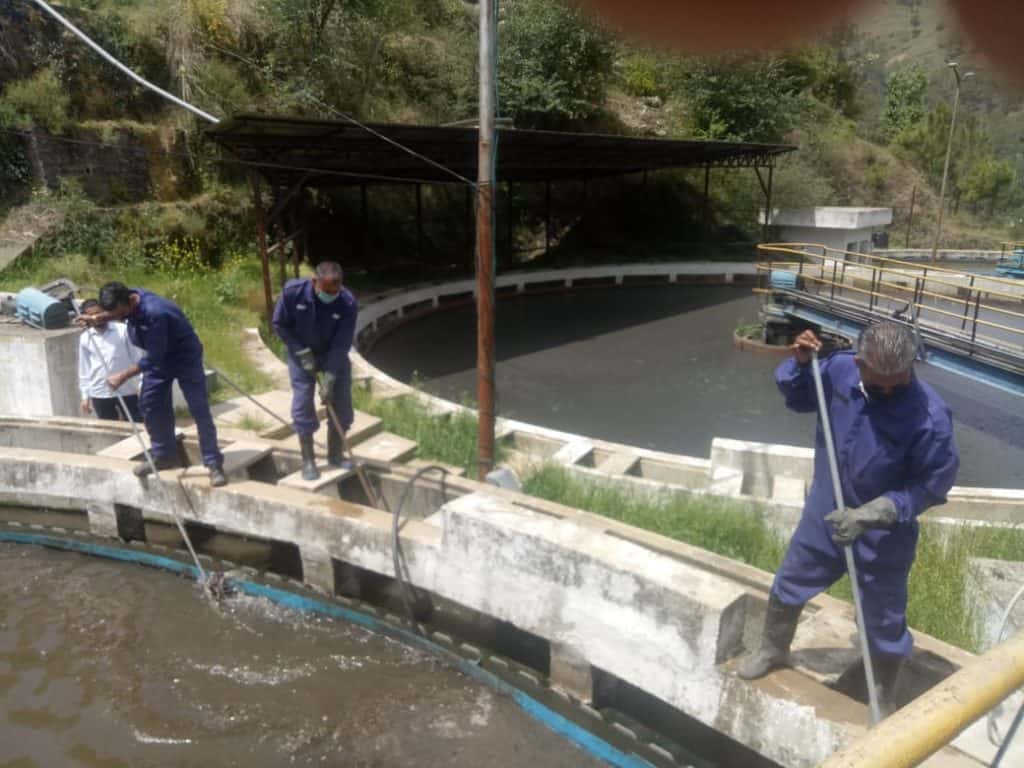They are a part of Shimla’s invisible corona warriors, the 260-odd sanitation workers who maintain the hill town’s 280-km sewerage network. “For the world, corona may be a novel virus, but we are exposed to infections and other health hazards every day,” says Attar Singh, a sewage worker, “though we do take due precautions to stay safe.” This, as they try and keep Shimla’s 2.3 lakh citizens safe from infections that lack of proper sewerage infrastructure and treatment can cause, including COVID (as recent news reports suggest).
Thankfully, Shimla town has not had a single positive case so far. Attar Singh and his fellow workers start early each morning, prepared to respond to any emergency call. For the past six weeks since the lockdown began, these sanitation workers are putting in extra hours to clean and maintain sewerage lines. Since plumbers have been unable to respond to house calls, most of them being stuck outside Shimla, the city’s municipal sewage teams are having to attend to residential complaints as well.
“Our work is demanding,” says Tek Chand, a supervisor. “Delays in fixing a broken pipe can expose residents to health risks.” A graduate with a diploma in environment studies, Tek Chand says their wages — Rs 7000-8000 a month — are not at all commensurate with the kind of job they perform. But he and his team carry on uncomplaining, “especially at this time when the country is fighting the deadly corona outbreak”. These workers are hired by an outside contractor, who is supposed to take care of their health protection and provide insurance cover.
Shimla hasn’t yet forgotten the massive 2015-16 jaundice outbreak which killed at least 30 people and affected about 70 percent of the town’s population. The cause of the outbreak was sewage contamination of drinking water supplied to the city from the Ashwani Khad water reservoir, which has since been shut down.
“Any lapse in sewage treatment and scientific disposal could affect hundreds of lives,” said Dharminder Gill, Managing Director, Shimla Jal Prabandhan Nigam (SJPN), a special purpose vehicle created after the jaundice outbreak to manage drinking water supply as well as the town’s sewerage network. “COVID-19 is a big challenge. We are alert 24X7, even as most other government functions are paused.”
Occupational hazards
Gill added that SJPN is fully committed to the workers’ well being and safety and that extra-care was being taken to ensure safe working conditions for sewerage workers, “who are also frontline corona warriors. They have all been provided protective kits including gloves, masks, gum shoes and required reusable Personal Protective Equipment’s (PPEs).” The workers were also given ration and other essentials.
The work brings with it several occupational hazards, ranging from infections to the potential danger from toxic gases, which can cause breathlessness, cardiovascular degeneration and skin problems. The most common cause of infection is hand-to-mouth contact during eating, drinking and smoking, or wiping the face with contaminated hands or gloves, or by licking splashes from the skin.
“There is high risk of allergies and skin infections,” said another supervisor Rajinder Singh. “Especially if there is a wound or cut. Workers at times have to go down into the gutter, manhole or drain using oxygen masks and full protective gear.”

The new requirement is following social distancing protocol, not just during work but also at home. Their protective gear also need regular washing and sanitisation. “The first duty on returning home is to ensure the safety of my family and kids,” said worker Krishan Chand. “I remove all my protection kits and sanitise myself properly before doing anything else. COVID-19 can only be fought following safety protocols.”
The SJPN gets 60 to 70 complaints every day which are acknowledged and attended to, said Gill. “Complaints relating to overflow, blockage and bursting of sewage lines are required to be attended within four to six hours. These days the SJPN is fast tracking all complaints, with teams rushing to the spot and fixing the problem within three to four hours.”
New projects
Shimla has six Sewage Treatments Plants (STPS) where waste water effluent and untreated sewage is treated using latest technologies. These plants have a total capacity of 35.63 MLD. They are currently handling 23.18 MLD, largely because of the complete shutdown of tourism and the fact that many people have gone back to their villages.
The city’s sewage infrastructure, originally laid during the British era for a population of 30,000, has undergone massive changes and augmentation. Currently, the SJPN is working on an ambitious plan to ensure that no waste water and sludge flows into drinking water sources, to keep them free from contamination.
The town is hoping to completely revamp its sewage network in the next four years with World Bank funding. It will be a modern network with minimal manual intervention. Currently, sewage workers face difficulties due to geographical and climatic factors as they get no break even during unexpected weather changes.
“We have a Rs 986 crore World Bank project in hand to ensure zero waste water by 2024,” said Gill. “The project has four major components, extension of sewage network to ensure that all households have a sewage connection, setting-up of three new STPs, Shimla drinking water project from Sutlej river and 24 X 7 water supply in town.”